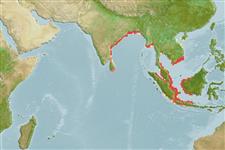>
Clupeiformes (Herrings) >
Engraulidae (Anchovies) > Engraulinae
Etymology: Stolephorus: Greek, stole, -es = garment + Greek, pherein = to carry (Ref. 45335).
Environment: milieu / climate zone / depth range / distribution range
Ecologie
marien; brak water; amfidroom (Ref. 51243); diepte 0 - 50 m (Ref. 189). Tropical; 25°N - 9°S, 80°E - 113°E (Ref. 189)
Eastern Indian Ocean: northern part of Bay of Bengal. Western Pacific: Gulf of Thailand, Java Sea to at least Kalimantan.
Grootte / Gewicht / Leeftijd
Maturity: Lm ? range ? - ? cm
Max length : 7.5 cm SL mannelijk / geslacht onbekend; (Ref. 189)
Dorsale stekels (totaal) : 0; Anale stekels: 0; Anale zachte stralen: 18 - 19. Belly with 4 to 7 small needle-like pre-pelvic scutes; a small pre-dorsal spine and another on the pelvic scute. Maxilla tip pointed, reaching to or beyond hind border of pre-operculum, the latter concave, indented near maxilla tip. Anal fin short, with origin below about middle of dorsal fin base. A double pigment line on back behind dorsal fin.
Presumed coastal, pelagic and schooling, but evidently tolerates lowered salinities (e.g. in the Godavari estuary, India; Songkla Lake, Thailand and Barito River estuary, Indonesia) and possibly such places are its main habitat. More data needed.
Levenscyclus en paargedrag
Maturities | Voortplanting | Spawnings | Egg(s) | Fecundities | Larven
Whitehead, P.J.P., G.J. Nelson and T. Wongratana, 1988. FAO Species Catalogue. Vol. 7. Clupeoid fishes of the world (Suborder Clupeoidei). An annotated and illustrated catalogue of the herrings, sardines, pilchards, sprats, shads, anchovies and wolf-herrings. FAO Fish. Synop. 125(7/2):305-579. Rome: FAO. (Ref. 189)
Status op de Rode Lijst van het IUCN (Ref. 130435)
Gevaar voor de mens
Harmless
Gebruik door de mens
Visserij: commercieel
Tools
Speciale rapporten
Download XML
Internetbronnen
Estimates based on models
Preferred temperature (Ref.
123201): 27.9 - 29.3, mean 28.8 °C (based on 456 cells).
Fylogenetische diversiteitsindex (Ref.
82804): PD
50 = 0.5000 [Uniqueness, from 0.5 = low to 2.0 = high].
Bayesian length-weight: a=0.00562 (0.00259 - 0.01222), b=3.18 (3.00 - 3.36), in cm total length, based on LWR estimates for this (Sub)family-body shape (Ref.
93245).
Trofisch niveau (Ref.
69278): 3.3 ±0.4 se; based on size and trophs of closest relatives
Weerstandsvermogen (Ref.
120179): Hoog, minimale populatieverdubbelingstijd minder dan 15 maanden (Preliminary K or Fecundity.).
Fishing Vulnerability (Ref.
59153): Low vulnerability (10 of 100).
